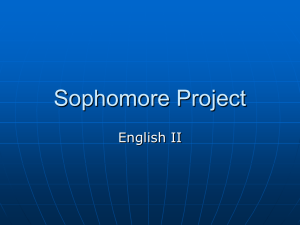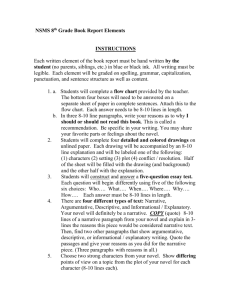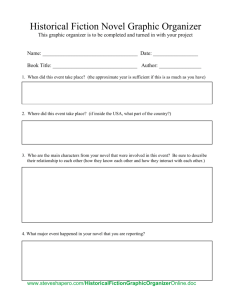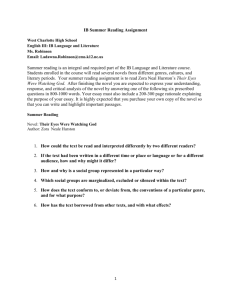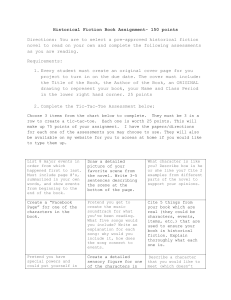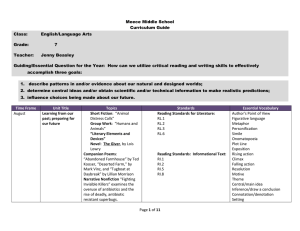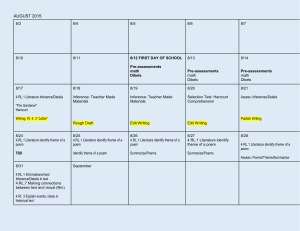Summer Reading Grade 7 and 8
advertisement
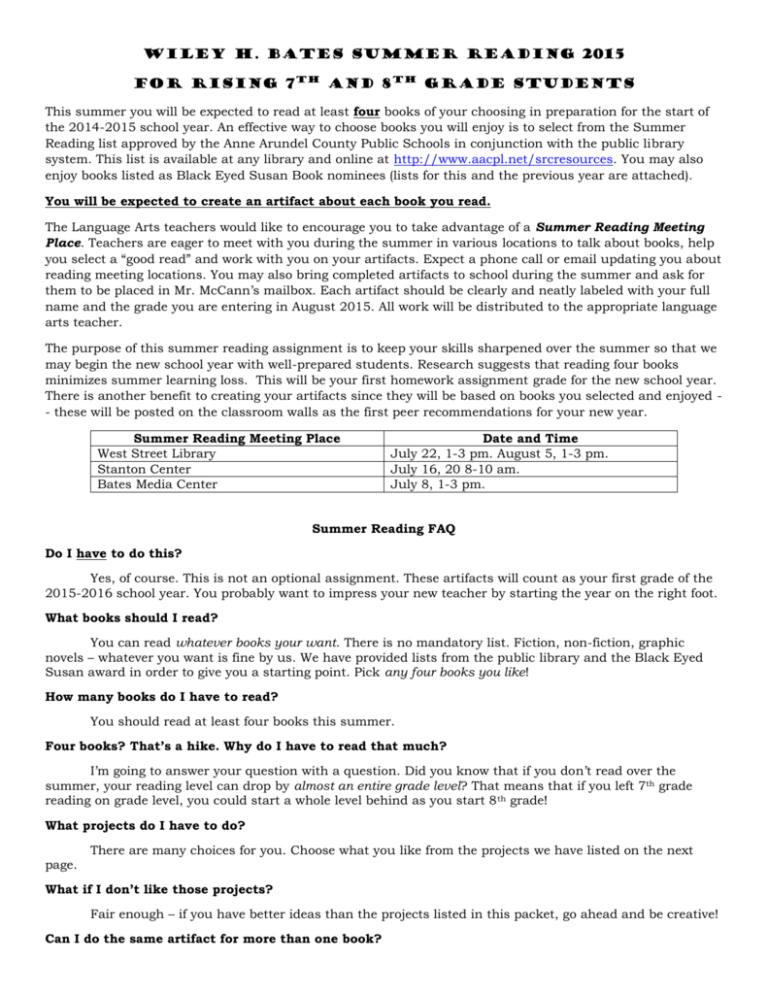
Wiley H. Bates Summer Reading 2015 For Rising 7th and 8th grade students This summer you will be expected to read at least four books of your choosing in preparation for the start of the 2014-2015 school year. An effective way to choose books you will enjoy is to select from the Summer Reading list approved by the Anne Arundel County Public Schools in conjunction with the public library system. This list is available at any library and online at http://www.aacpl.net/srcresources. You may also enjoy books listed as Black Eyed Susan Book nominees (lists for this and the previous year are attached). You will be expected to create an artifact about each book you read. The Language Arts teachers would like to encourage you to take advantage of a Summer Reading Meeting Place. Teachers are eager to meet with you during the summer in various locations to talk about books, help you select a “good read” and work with you on your artifacts. Expect a phone call or email updating you about reading meeting locations. You may also bring completed artifacts to school during the summer and ask for them to be placed in Mr. McCann’s mailbox. Each artifact should be clearly and neatly labeled with your full name and the grade you are entering in August 2015. All work will be distributed to the appropriate language arts teacher. The purpose of this summer reading assignment is to keep your skills sharpened over the summer so that we may begin the new school year with well-prepared students. Research suggests that reading four books minimizes summer learning loss. This will be your first homework assignment grade for the new school year. There is another benefit to creating your artifacts since they will be based on books you selected and enjoyed - these will be posted on the classroom walls as the first peer recommendations for your new year. Summer Reading Meeting Place West Street Library Stanton Center Bates Media Center Date and Time July 22, 1-3 pm. August 5, 1-3 pm. July 16, 20 8-10 am. July 8, 1-3 pm. Summer Reading FAQ Do I have to do this? Yes, of course. This is not an optional assignment. These artifacts will count as your first grade of the 2015-2016 school year. You probably want to impress your new teacher by starting the year on the right foot. What books should I read? You can read whatever books your want. There is no mandatory list. Fiction, non-fiction, graphic novels – whatever you want is fine by us. We have provided lists from the public library and the Black Eyed Susan award in order to give you a starting point. Pick any four books you like! How many books do I have to read? You should read at least four books this summer. Four books? That’s a hike. Why do I have to read that much? I’m going to answer your question with a question. Did you know that if you don’t read over the summer, your reading level can drop by almost an entire grade level? That means that if you left 7th grade reading on grade level, you could start a whole level behind as you start 8 th grade! What projects do I have to do? There are many choices for you. Choose what you like from the projects we have listed on the next page. What if I don’t like those projects? Fair enough – if you have better ideas than the projects listed in this packet, go ahead and be creative! Can I do the same artifact for more than one book? Sure. Why not? This FAQ doesn’t answer my questions. That makes sense. Email McCann at mfmccann@aacps.org Artifact Summary Focus Novel Thinking Map: Create a flow map of major events OR a multi-flow map showing how the conflict affected the plot (did the conflict create the character, change the character, make it suspenseful, etc.) Make sure to include: Book title and author’s name. Flow map of events with parts of plot labelled (5 parts minimum). o OR – multi-flow map with specific text details (Minimum of 2 causes and 2 effects). Respond to the frames question: How do the conflicts or events make this a good book to read? Informational Thinking Map: Create a Thinking Map that expresses the information in the book (map will depend on the topic and the way the author organizes facts) Book title and author’s name Thinking Map with minimum 5 boxes Frame: Explain how the author organizes the facts Persuasive Focus Persuasive Paragraph: advocate for a Book Club to select your book. The paragraph must include: Book title and author’s name Clear and specific claim (I think…) Two arguments to back your claim Three quotes from the book to support the arguments (narrative/novel or informational book) Choices Summary Focus Narrative/Novel One Pager: Provides a summary of the novel plot that includes: Book title and author’s name Three or more events Main character’s name and description Explanation of the major conflict Explains how the conflict was resolved Informational One Pager: provides an overview of the information and key ideas from the text Includes a clear statement of the text main idea Includes two or more supporting details from the text Includes a graphic representation (some kind of drawing or illustration)and a text feature that enhances the reader’s understanding of the article Character Focus Character Interview: Choose one character (human or non-human) and imagine you could interview him/her. How would s/he respond? Your questions and responses must demonstrate an understanding of the character. Book title and author name Introductory sentences that include character name and role in the novel or informational text 3 questions and 3 appropriate responses Each response is a minimum of 2 sentences (novel/narrative book or informational text) Design Focus Create a book jacket, like what protects a hardcover book. Create a front and back cover for your book that helps to urge a reader to pick up the book. Your cover should incorporate good elements of design. It should also summarize the book. Artistic Focus Create your own artistic expression of the novel using your fantastic arts talent. Make sure to include a one paragraph artist statement. Some options include: Character portraits Song composition Visual Journal Act out scenes from the book You can feel free to customize this project. Creative Writing Focus Compose an original work that summarizes, reacts to, and extends the text in some way. Ideas include: Prequel or sequel (write the story that happens before or after the book) Missing chapter (write chapter 22.5, for instance, to fill in any gaps you want covered in your book) Perspective switch (write part of the book from another character’s perspective) Social Focus Create a Facebook, Twitter, or Instagram feed for your favorite character from this book. Have fun letting characters interact in your created world. Aim for ten posts, tweets, or grams. Work to make your page look like the real thing.
